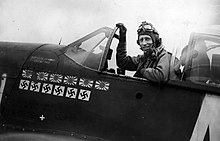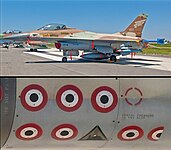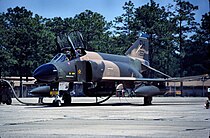|
Victory marking
 A victory marking (also called a victory mark, kill marking, or kill mark, or mission symbol) is a symbol applied in stencil or decal to the side of a military aircraft, ship or ground vehicle to denote a victory achieved by the pilot or crew against an aerial target. The use of victory markings originated during World War I, burgeoned during World War II and frequently took the form of the roundel or national flag of the nationality of the military target defeated.[1] Sometimes damaged targets also included, but the mark will be slightly different to distinguish them from those targets that are destroyed.[2] These enemy targets can be planes, helicopters, trains, ships and sea mines in World War II,[2] which later also include cruise missiles and drones in subsequent conflicts.[3] The manner of destruction that qualify for a victory mark also varies, from bombs and cannons by planes, deck guns by ships to torpedoes by submarines.[2] In 2012, a German Eurofighter was spotted with a kill mark denoting a simulated victory over a U.S. Air Force F-22 Raptor, achieved in a dogfight during a training exercise.[4] In the United States Air Force, as of 2010, victory markings are applied in the form of six inch green stars set within a black border with the type of aircraft defeated stencilled inside the star in white lettering.[5] In the Russo-Ukrainian War, Ukrainian anti-air defenses such as Flakpanzer Gepards and Patriot Missile systems are decorated with victory markings for successfully shooting down Russian aerial targets, missiles and Iranian Shahed drones.[6][3] Mission symbolVictory marks have been applied to aircraft for reasons other than aerial victories. During the period of its use for astronaut recovery, the U.S. Navy's Helicopter 66 bore victory marks showing a space capsule silhouette, with one mark added for each recovery in which it participated.[7] Gallery
See alsoReferences
Further reading
External links
|








